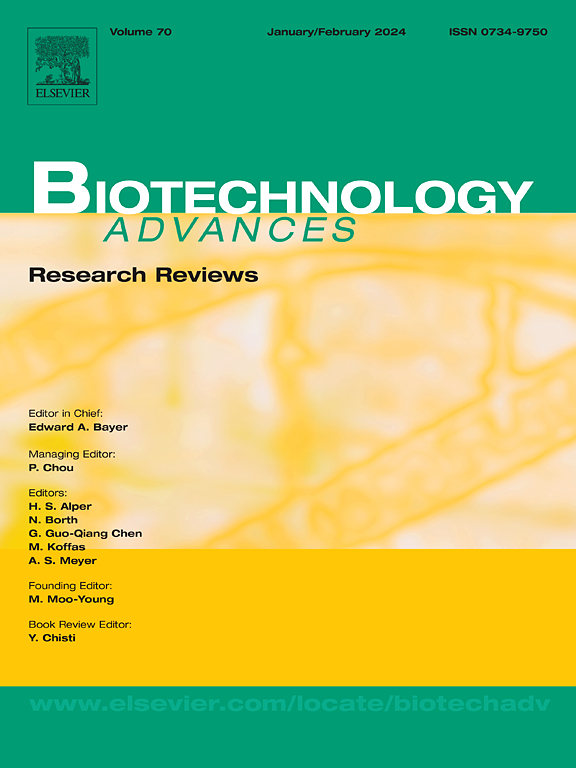Sugar phosphatases as biocatalysts for biomanufacturing: Recent advances and applications
IF 12.1
1区 工程技术
Q1 BIOTECHNOLOGY & APPLIED MICROBIOLOGY
引用次数: 0
Abstract
Phosphatases, the largest subgroup within the haloacid dehydrogenase (HAD) superfamily, catalyze the irreversible dephosphorylation of phosphate biomolecules. In in vitro synthetic enzymatic biosystems, sugar phosphatases drive the pathways of phosphorylation, transformation (isomerization, epimerization, dehydrogenation, and/or transamination), and dephosphorylation towards product formation through irreversible and exothermic reactions. This process enables enzymatic cascades based on phosphorylation-dephosphorylation to overcome the thermodynamic limitations of traditional functional sugar production methods that rely on isomerases or epimerases, potentially leading to high theoretical conversion rates. However, sugar phosphatases often exhibit broad substrate scope, which can result in dephosphorylation of intermediates within enzymatic biosystems. In this review, we begin by reviewing the classification, structural features, and catalytic mechanisms of phosphatases, followed by the molecular mechanisms underlying substrate promiscuity. The current research on the substrate specificity engineering of phosphatases is then discussed, with particular focus on the production of functional sugars using sugar phosphatase-driven in vitro synthetic enzymatic biosystems. Our goal is to provide a comprehensive overview of the current research status, challenges, and future trends related to sugar phosphatases-mediated biomanufacturing, offers valuable insights into the enzymatic modification and application of these enzymes.
糖磷酸酶作为生物制造的生物催化剂:最新进展和应用。
磷酸酶是卤酸脱氢酶(HAD)超家族中最大的亚群,催化磷酸生物分子的不可逆去磷酸化。在体外合成酶生物系统中,糖磷酸酶通过不可逆和放热反应驱动磷酸化、转化(异构化、外映异构化、脱氢和/或转氨化)和去磷酸化形成产物的途径。该过程使基于磷酸化-去磷酸化的酶级联反应克服了依赖于异构酶或外链酶的传统功能糖生产方法的热力学限制,有可能导致高的理论转化率。然而,糖磷酸酶通常表现出广泛的底物范围,这可能导致酶生物系统中的中间体去磷酸化。在这篇综述中,我们首先回顾了磷酸酶的分类、结构特征和催化机制,然后是底物混杂的分子机制。然后讨论了目前对磷酸酶底物特异性工程的研究,特别关注利用糖磷酸酶驱动的体外合成酶生物系统生产功能糖。我们的目标是全面概述糖磷酸酶介导的生物制造的研究现状、挑战和未来趋势,为这些酶的酶修饰和应用提供有价值的见解。
本文章由计算机程序翻译,如有差异,请以英文原文为准。
求助全文
约1分钟内获得全文
求助全文
来源期刊

Biotechnology advances
工程技术-生物工程与应用微生物
CiteScore
25.50
自引率
2.50%
发文量
167
审稿时长
37 days
期刊介绍:
Biotechnology Advances is a comprehensive review journal that covers all aspects of the multidisciplinary field of biotechnology. The journal focuses on biotechnology principles and their applications in various industries, agriculture, medicine, environmental concerns, and regulatory issues. It publishes authoritative articles that highlight current developments and future trends in the field of biotechnology. The journal invites submissions of manuscripts that are relevant and appropriate. It targets a wide audience, including scientists, engineers, students, instructors, researchers, practitioners, managers, governments, and other stakeholders in the field. Additionally, special issues are published based on selected presentations from recent relevant conferences in collaboration with the organizations hosting those conferences.
 求助内容:
求助内容: 应助结果提醒方式:
应助结果提醒方式:


